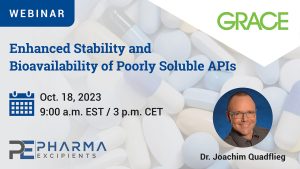Investigating the Impact of Co-processed Excipients on the Formulation of Bromhexine Hydrochloride Orally Disintegrating Tablets (ODTs)

Abstract
Purpose
Orodispersible tablets (orally disintegrating tablets, ODTs) have been used in pharmacotherapy for over 20 years since they overcome the problems with swallowing solid dosage forms. The successful formula manufactured by direct compression shall ensure acceptable mechanical strength and short disintegration time. Our research aimed to develop ODTs containing bromhexine hydrochloride suitable for registration in accordance with EMA requirements.
Methods
We examined the performance of five multifunctional co-processed excipients, i.e., F-Melt® C, F-Melt® M, Ludiflash®, Pharmaburst® 500 and Prosolv® ODT G2 as well as self-prepared physical blend of directly compressible excipients. We tested powder flow, true density, compaction characteristics and tableting speed sensitivity.
Results
The manufacturability studies confirmed that all the co-processed excipients are very effective as the ODT formula constituents. We noticed superior properties of both F-Melt’s®, expressed by good mechanical strength of tablets and short disintegration time. Ludiflash® showed excellent performance due to low works of plastic deformation, elastic recovery and ejection. However, the tablets released less than 30% of the drug. Also, the self-prepared blend of excipients was found sufficient for ODT application and successfully transferred to production scale. Outcome of the scale-up trial revealed that the tablets complied with compendial requirements for orodispersible tablets.
Conclusions
We proved that the active ingredient cannot be absorbed in oral cavity and its dissolution profiles in media representing upper part of gastrointestinal tract are similar to marketed immediate release drug product. In our opinion, the developed formula is suitable for registration within the well-established use procedure without necessity of bioequivalence testing.
Download the full article as PDF here Investigating the Impact of Co-processed Excipients on the Formulation of Bromhexine Hydrochloride Orally Disintegrating Tablets (ODTs)
or read it here
Materials
All the co-processed excipients were kindly gifted by their manufacturers: F-Melt® type C and type M (Fuji Chemical Industries Co., Ltd., Osaka, Japan), Ludiflash® (BASF, Ludwigshafen, Germany), Pharmaburst® 500 (SPI Pharma, Wilmington, DE, USA) and Prosolv® ODT G2 (JRS Pharma, Rosenberg, Germany). Ingredients for physical blend were purchased from their producers: mannitol – Pearlitol® (Roquette, Lestrem, France), microcrystalline cellulose Avicel® (FMC, Philadelphia, PA, USA), Kollidon® CL (BASF, Ludwigshafen, Germany), Aerosil® 200 (Evonik, Essen, Germany). Sodium stearyl fumarate – Novalube®, used as a lubricant, was provided from Nitika Pharmaceutical Specialities PVT. Ltd. (Nagpur, India). Bromhexine hydrochloride (BRX) was purchased from VenPetrochem (Mumbai, India). All chemicals were of pharmacopoeial or analytical grade.
Woyna-Orlewicz, K., Brniak, W., Tatara, W. et al. Investigating the Impact of Co-processed Excipients on the Formulation of Bromhexine Hydrochloride Orally Disintegrating Tablets (ODTs). Pharm Res (2023). https://doi.org/10.1007/s11095-023-03605-x
See the webinar:
“Enhanced Stability and Bioavailability of Poorly Soluble APIs“,
18 October 2023:
Get more information & register here for free:


